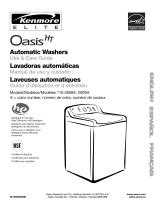
Stains, gray whites, dingy colors
• Did you properly sort the load? Dye transfer can occur
when mixing whites and colors in a load. Sort dark clothes
from whites and lights.
• Was the wash temperature too low? Use hot or warm
washes if safe for the load. Make sure your hot water system
is adequate to provide a hot water wash.
• Did you use enough detergent, or do you have hard
water? Use more detergent for washing heavy soils in cold or
hard water.
Are the hot and cold water hoses reversed? Check to be
sure the hot and cold water hoses are connected to the right
faucets. See "Connect the Inlet Hoses" in the Installation
Instructions.
• Did you follow the manufacturer's directions when adding
detergent and fabric softener? Measure detergent and
fabric softener. Use enough detergent to remove soil and hold
it in suspension. Dilute fabric softener and add to the rinse
portion of a cycle only. Do not drip fabric softener on clothes.
• Is there above average iron (rust) in water? You may need
to install an iron filter.
Garments damaged
• Were sharp items removed from pockets before washing?
Empty pockets, zip zippers, snap or hook fasteners before
washing to prevent snagging and tearing of load.
• Were strings and sashes tied to prevent tangling? Straps
and strings can easily become entangled in the load, causing
strain on seams and tearing.
• Were items damaged before washing? Mend rips and
broken threads in seams before washing.
• Did you overload the washer? The wash load must be
balanced and not overloaded. Loads should move freely
during washing.
• Did you add chlorine bleach properly? Do not pour chlorine
bleach directly onto load. Wipe up bleach spills. Undiluted
bleach will damage fabrics. Do not place load items on top of
the bleach dispenser when loading and unloading the washer
(on some models). Do not use more than than the
manufacturer's recommended amount for a full load.
• Did you follow the manufacturer's care label instructions?
PROTECTION AGREEMENTS
Master Protection Agreements
Congratulations on making a smart purchase. Your new Kenmore ®
product is designed and manufactured for years of dependable
operation. But like all products, it may require preventive
maintenance or repair from time to time. That's when having a
Master Protection Agreement can save you money and aggravation.
Purchase a Master Protection Agreement now and protect
yourseff from unexpected hassle and expense.
Sears has over 12,000 professional repair specialists, who have
access to over 4.5 million quality parts and accessories. That's
the kind of professionalism you can count on to help prolong the
life of your new purchase for years to come. Purchase your
Master Protection Agreement today!
Some limitations and exclusions apply. For prices and
additional information, call 1-800-827-6655.
Sears Installation Service
For Sears professional installation of home appliances, garage
door openers, water heaters, and other major home items, in the
U.S.A. call 1-800-4-MY-HOME ®.
The Master Protection Agreement also helps extend the life of
your new product. Here's what's included inthe Agreement:
v' Expert service by our 12,000 professional repair specialists
v' Unlimited service and no charge for parts and labor on all
covered repairs
v' "No-lemon" guarantee - replacement of your covered product
if four or more product failures occur within twelve months
v' Product replacement if your covered product can't be fixed
v' Annual Preventive Maintenance Check at your request - no
extra charge
v' Fast help by phone - phone support from a Sears technician
on products requiring in-home repair, plus convenient repair
scheduling
v' Power surge protection against electrical damage due to
power fluctuations
v' Rental reimbursement if repair of your covered product takes
longer than promised
Once you purchase the Agreement, a simple phone call is all that
it takes for you to schedule service. You can call anytime day or
night, or schedule a service appointment online.
Maintenance Agreements
Your purchase has added value because you can depend on
Sears HomeCentraP for service. With over 2,400 Service
Technicians and more than a million parts and accessories, we
have the tools, parts, knowledge and skills to back our pledge:
We Service What We Sell.
Your Kenmore ®product is designed, manufactured and tested to
provide years of dependable operation. But like all products, it
may require service from time to time. The Sears Maintenance
Agreement offers you an outstanding service program, affordably
priced.
The Sears Maintenance Agreement
• Is your way to buy tomorrow's service at today's price
• Eliminates repair bills resulting from normal wear and tear
• Provides phone support from a Sears technician on products
requiring in-home repair
• Even if you don't need repairs, provides an annual Preventive
Maintenance Check, at your request, to ensure that your
product is in proper running condition.
Some limitations apply. For more information about Sears
Canada Maintenance Agreements, call 1-800-361-6665.
10












